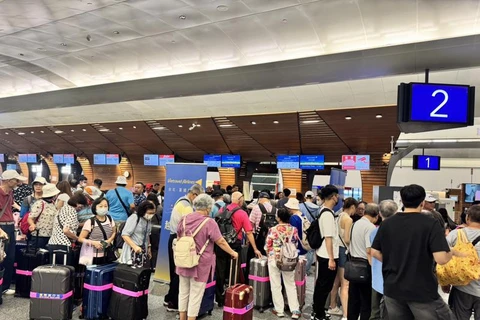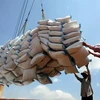
Hanoi (VNA) – Vietnamese airlines have been taking various measures in the face of a fleet contraction triggered by the manufacturer’s engine recall, including adding and replacing aircraft.
As of July, there were 195 aircraft of Vietnamese carriers granted air operator certificates (AOC), 36 less than a year earlier. Among them, an average of 167 planes were operated during the period, down 51, according to the Civil Aviation Authority of Vietnam (CAAV).
About 94.4% of the aircraft granted AOCs were operated in 2023, but the rate has fallen to 85.6% this year due to impact of the engine recall.
Meanwhile, the CAAV forecast the air transport market in 2024 will record approximately 78.3 million passengers and 1.21 million tonnes of cargo, respectively increasing 7.7% and 13.4% from last year.
Facing that fact, domestic carriers have continually leased aircraft.
So far this year, Bamboo Airways has conducted wet-leasing, also known as ACMI (aircraft, crew, maintenance, and insurance) leasing, of three planes to fly on in-demand routes in the summer travel season like those connecting with Nha Trang, Da Nang, and Quy Nhon.
General Director of Bamboo Airways Luong Hoai Nam said the firm has strived to add more aircraft to its fleet to serve the domestic market by seeking and negotiating with partners worldwide. It plans to lease another aircraft between now and the year’s end to open some new domestic routes such as Ho Chi Minh City - Da Lat, HCM City - Thanh Hoa, and HCM City - Phu Quoc.
Le Hong Ha, General Director of Vietnam Airlines, predicted that the aircraft shortage may linger on to 2025.
He noted the national flag carrier has devised many solutions, including suspending or reducing the frequency of some routes in off-peak times or inefficient ones, increasing the operational time of each aircraft, and wet-leasing some planes.
The airline is also boosting flights with attractive ticket prices in early mornings and late evenings. Occupancy rates of the flights to tourist magnets like Hanoi, HCM City, Da Nang, Nha Trang, Da Lat, Quy Nhon, and Phu Quoc that took off after 9pm and before 5am in May and June were high, reaching 75 - 94%, Ha added.
For its part, Vietjet plans to receive 10 planes between now and the end of 2024, including eight A321Neos and two E190s. It is scheduled to add more A321Neo, A330-300, E190, and Boeing 737 Max to its fleet in 2025.
However, CAAV Deputy Director Do Hong Cam pointed out that it is still hard for carriers to lease aircraft due to rising rental, increasing fuel prices, and foreign exchange rate differences. These factors have affected supply and are among the reasons behind airfare fluctuations on domestic routes.
Sharing the view, Deputy Minister of Transport Le Anh Tuan said the aviation sector will still encounter numerous difficulties in the coming time, including the aircraft shortage, carriers’ restructuring, route rearrangement, higher fuel costs, and foreign exchange differences.
During the first half of 2024, Vietnamese airlines served nearly 37.5 million passengers, up 3.7% year on year and equivalent to 96% of the figure in the same period of 2019, when the aviation market was enjoying good growth. Notably, they included 20.2 million passengers on international routes, soaring 38.6% year on year and equivalent to that in H1 of 2019, statistics show.
Vietnam's aviation safety index was rated at 77.1%, up 11.54% from 2016 and well above the Asia-Pacific average of 65.31% and the global average of 68.81%, according to the Universal Safety Oversight Audit Programme of the International Civil Aviation Organisation (ICAO)./.






















